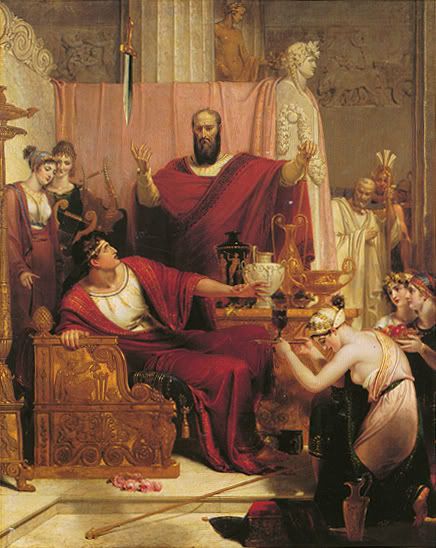Richard Westall, The Sword of Damocles (Painting, 1812)
Dionysius, who had seized power in the city of Syracuse, overheard the young man Damocles envying his good fortune. "Very well," said the ruler. "If you think my position is so enviable, you may change places with me for a day."
As Damocles sat feasting in the palace, he happened to glance upward and was horrified to see a sharp sword hanging above him by a single thread. "Are you surprised?" said Dionysius. "I came to power by violence, and I have many enemies. Every day that I rule this city, my life is in as much danger as yours is at this moment."
If you are familiar with allusions to the "sword of Damocles," you may know that to feel that the sword of Damocles is hanging over you is to have a sense of anxiety, of impending doom.
As Damocles sat feasting in the palace, he happened to glance upward and was horrified to see a sharp sword hanging above him by a single thread. "Are you surprised?" said Dionysius. "I came to power by violence, and I have many enemies. Every day that I rule this city, my life is in as much danger as yours is at this moment."
If you are familiar with allusions to the "sword of Damocles," you may know that to feel that the sword of Damocles is hanging over you is to have a sense of anxiety, of impending doom.
The reference is to a story recounted by the Roman writer Cicero in the first century B.C. Damocles was a courtier in Syracuse during the reign of a powerful tyrant named Dionysius. Tired of hearing his young courtier go on and on about how wonderful the life of a ruler must be, Dionysius decided to teach Damocles a lesson. Damocles was treated to a lavish banquet in which he was to experience what it really felt like to be a ruler. In the midst of the festivities, he noticed a sword suspended overhead by a single horsehair. Damocles' resulting anxiety was similar to the worries and responsibilities that go along with the pleasures of a ruler's position. With a better understanding of Dionysius' life, Damocles became more content with his own role as an attendant to the ruler.
In 1811 the English Neoclassical artist Richard Westall painted the first of two versions representing this ancient story for an English collector named Richard Payne Knight. The 1811 version was exhibited at the Royal Academy, where it attracted the attention of another wealthy patron of the arts, Thomas Hope. Hope commissioned a larger version of the Damocles painting from Westall. It is this larger version from 1812 that hangs in the nineteenth-century gallery of the Ackland Art Museum.
The Sword of Damocles is typical of the Neoclassical style. It was painted in the same year that Lord Elgin brought the marble sculptures from the Parthenon in Athens to England, and there was enthusiastic interest in the classical world. Thomas Hope himself had an extensive collection of classical vases and statuary, some of which Westall included in his painting to make the setting seem more authentic. Several costumes and hairstyles were also derived from works in Hope's collection. Beside the choice of an ancient narrative and classical setting, Damocles shows rather the static, stage-like composition characteristic of much Neoclassical painting. The didactic element is also central to Neoclassical concerns. These artists intended to instruct and improve their viewers, and Westall's carefully contrived presentation of Damocles' story was meant to teach his early nineteenth century contemporaries the same lesson that the foolish young courtier needed so many centuries earlier. [source]


